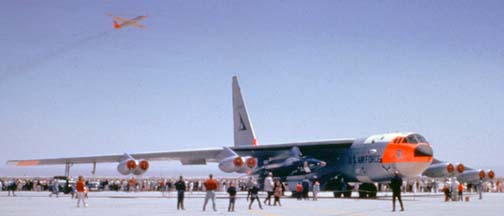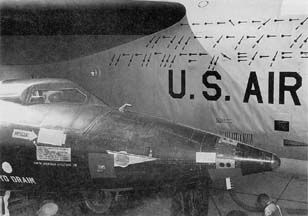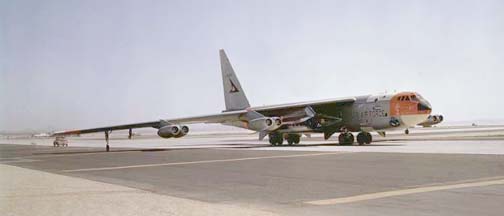Forty Years Ago in the X-15 Flight
Test Program, May 1962
|
 At the beginning of May 1962, Major
Robert Rushworth was preparing to fly an airframe heating
investigation with the X-15-2, but first it would be carried
across the country by the NB-52A to appear at the Eglin Air Force
Base airshow. Major Bob White was planning to evaluate the
performance of the Alternate Stability Augmentation System (ASAS)
of the X-15-1 at high angle of attack.
At the beginning of May 1962, Major
Robert Rushworth was preparing to fly an airframe heating
investigation with the X-15-2, but first it would be carried
across the country by the NB-52A to appear at the Eglin Air Force
Base airshow. Major Bob White was planning to evaluate the
performance of the Alternate Stability Augmentation System (ASAS)
of the X-15-1 at high angle of attack.
The X-15-2 was displayed at an airshow at Eglin Air Force Base
in Florida over the first weekend of May 1962. Major Jack Allavie
piloted the NB-52A across the country with the X-15-2 on the
pylon on May 2. Major Bob White went along as co-pilot. That was
the only occasion on which an NB-52 landed with an X-15 away from
Edwards. They returned the X-15-2 to Edwards Air Force Base on
May 5.
One of the main parameters that aerospace engineers are
concerned with is called dynamic pressure. The dynamic pressure
that an airplane encounters is directly related to the speed of
the airplane and the density of the atmosphere through which it
is flying. The effectiveness of aerodynamic control surfaces and
the rate of airframe heating from aerodynamic friction are both
related to the value of the dynamic pressure. Engineers use the
letter q to represent dynamic pressure. The value of q at typical
X-15 launch conditions (45,000 feet altitude and an airspeed of
450 miles per hour) is about 145.
After Major White endured two aborts of the X-15-1 airframe
heating flight in April, Major Robert Rushworth was assigned to
fly the twenty-second flight of the X-15-1.
The flight plan called for Major Rushworth to make a 20 degree
climb at full throttle to an altitude of 54,000 feet, followed by
a pushover to zero-g flight. Rushworth was to level off at 73,000
feet and throttle back to 30% thrust, adjusting the speed brakes
to keep the speed of the X-15-1 at about 3,400 miles per hour.
During this period, the value of dynamic pressure (q) would
exceed 2,000 for the first time during an X-15 flight. The engine
would burn out after about 103 seconds. After burnout Rushworth
would make a 5-g turn to the right. As the X-15 decelerated, he
was to turn off the channels of the SAS, one at a time, to
evaluate the response of the ASAS.
Major Rushworth was scheduled to fly the X-15-2 on May 7, but
overcast skies postponed the launch for a day. The NB-52B took
off on May 8 with Major Allavie and Major Russell Bement at the
controls. Jack Russel occupied the launch panel operator's
station behind the pilots. The number four J57 jet engine
malfunctioned and was shut down. The flight progressed on the
power of the Stratofortress' other seven engines.
Rushworth triggered the drop of the X-15-2 over Hidden Hills
Lake and started climbing at full throttle. He leveled off at
70,000 feet and throttled the XLR-99 engine to 30% thrust. This
was the first time that the XLR-99 had flown at less than 50%
thrust. Rushworth extended the speed brakes 16 degrees to
maintain a speed of mach 5 for 33 seconds. The edges of the speed
brake panels were heated to a tempertature of 1,250 degrees
Fahrenheit by aerodynamic friction. The pressure in the cockpit
of the X-15 dropped, and Rushworth's pressure suit inflated just
as the rocket engine consumed the last of its fuel. The X-15 was
traveling mach 5.34 (3,524 miles per hour) at engine burn out.
Rushworth rolled the X-15 ninety degrees to the right and pulled
back on the stick until he was subjected to 4.5 gs. Rushworth was
impressed by the "snap, crackle, and pop" sounds
emanating from the X-15 as it glided back to Edwards Air Force
Base.
The 1962 Edwards Air Force Base Open House was held on May 20.
Major Allavie and RAF Squadron Leader Harry Archer piloted the
NB-52B as it participated in the rehearsal for the aerial display
on May 19. The X-15-3 was mounted on the wing of the NB-52A and
they were placed on static display on the flightline during the
airshow. Major Miles Burganheim occupied the co-pilot's seat of
the NB-52B as Major Allavie flew it past the crowd on May 20.
 NB-52A displayed with the X-15-3 suspended from
the pylon at the Edwards AFB Open House on May 20, 1962. Photo by
Tom Brewer via Greg Spahr.
NB-52A displayed with the X-15-3 suspended from
the pylon at the Edwards AFB Open House on May 20, 1962. Photo by
Tom Brewer via Greg Spahr.
Rushworth was assigned to fly the twenty-eighth flight of the
X-15-1 two days after the open house. The X-15-3 was removed from
the pylon of the NB-52A and the X-15-1 took its place. The
primary purpose of the flight was an investigation of boundary
layer flow around the airframe of the X-15. The flight plan
called for Rushworth to pull up to a climb of 30 degrees at full
throttle, then push over to zero-g flight until leveling out at
an altitude of 90,000 feet. He was to shut down the engine after
77 seconds . After shutting down the engine, he was to pitch the
nose up and down in steps of 5 degrees between 10 degrees nose up
and ten degrees nose down three times.
 The X-15-1 on the wing of the NB-52A. This photo may have been
taken during the preparation for launch of mission 1-28-49 on May
22, 1962. Note the multi-probe pressure rakes mounted around the
nose of the X-15. The probes measured the airspeed at several
distances from the skin of the X-15 simultaneously. The air
closest to the skin of the rocket plane (called the boundary
layer) moves slower than the air farther away. A special X-15
silhouette, pointing to the left, was added to the scoreboard on
the side of the NB-52A to commemorate the return flight from
Eglin Air Force Base on May 5. It appears at far right on the
bottom. Photo courtesy NASA.
The X-15-1 on the wing of the NB-52A. This photo may have been
taken during the preparation for launch of mission 1-28-49 on May
22, 1962. Note the multi-probe pressure rakes mounted around the
nose of the X-15. The probes measured the airspeed at several
distances from the skin of the X-15 simultaneously. The air
closest to the skin of the rocket plane (called the boundary
layer) moves slower than the air farther away. A special X-15
silhouette, pointing to the left, was added to the scoreboard on
the side of the NB-52A to commemorate the return flight from
Eglin Air Force Base on May 5. It appears at far right on the
bottom. Photo courtesy NASA.
Major Allavie and Captain John Campbell were at the controls
of the NB-52A on the morning of May 22. Jack Russel managed the
systems of the X-15 using the launch panel controls, observing
the rocket plane on the twin television monitors that occupied
the space between his station and the pilot's seats.
After Rushworth launched the X-15-2 over Hidden Hills Lake, he
was immediately aware that its roll stability was not as good as
expected. He had to constantly counteract its tendency to roll to
the left through the entire flight. At an altitude of 96,000
feet, an overspeed of the turbopump of the XLR-99 triggered an
early shut down of the engine after a burn of 75.3 seconds, when
the X-15-1 was going mach 5.03 (3,450 miles per hour). It was
still climbing and reached a peak altitude of 100,400 feet, over
10,000 feet higher than planned. Rushworth dropped the nose
slightly to get it back on profile, then pitched the nose up and
down in controlled increments to collect the desired boundary
layer flow data.
Major BobWhite was scheduled to make the twenty-third flight
of the X-15-2 on May 24. The primary purpose of the flight was to
evaluate the performance of the ASAS at an angle of attack of 23
degrees. The flight plan called for White to pull up to a climb
angle of 30 degrees at full throttle to an altitude of 56,000
feet, then push over to zero-g flight for forty seconds.
Seventy-five seconds into the flight he was to pull up so that
the X-15 was pulling 2 gs for the last eighteen seconds of
powered flight. After the XLR-99 engine consumed the last of its
propellants, White was to pull up to an angle of attack of 23
degrees, disengage the roll channel of the primary Stability
Augentation System (SAS) and observe the behavior of the X-15 as
the ASAS kicked in. Then he would re-engage the SAS and roll the
X-15 thirty degrees to the right while holding the angle of
attack at 20 degrees for twenty seconds during the ascent. The
X-15 should reach a peak altitude of 162,000 feet three minutes
after launch.
Bad weather on the morning of May 24 resulted in a
postponement of the flight until the next day. Major Fitzhugh
Fulton and Major Russell Bement took the NB-52B aloft with White
in the cockpit of the X-15-2 on May 25. As Jack Russel was
setting up the inertial navigation system, the stable table
overheat light came on, causing the mission to be rescheduled for
May 28. It was postponed again to May 29, but the stable table
malfunctioned again that day. This was the fourth consecutive
launch abort for Major White.
 The NB-52B taxis out with the X-15-2 on May 25,
1962. The launch was aborted when the stable table overheat light
came on. The last mission mark on the fuselage represents mission
1-27-48, flown on April 30. Photo courtesy AFFTC/HO
The NB-52B taxis out with the X-15-2 on May 25,
1962. The launch was aborted when the stable table overheat light
came on. The last mission mark on the fuselage represents mission
1-27-48, flown on April 30. Photo courtesy AFFTC/HO
Major Rushworth scheduled to fly the fifth flight of the
X-15-3 on May 29. The primary purpose of the flight was to
familiarize Rushworth with the operation of the MH-96 adaptive
gain flight control system that equipped X-15-3 and to evaluate
its control of the reaction control system (RCS) while the X-15
was above the atmosphere. The flight plan called for him to
ignite the XLR-99 engine at 75% thrust, then throttle up to 100%
thrust and pull up to a climb angle of 32 degrees. He would shut
down the rocket engine 77 seconds into the flight, at an altitude
of 117,000 feet while the X-15 was going mach 5.15. During the
ascent to the peak altitude of 206,000 feet he would roll the
X-15 from side to side and then pitch the nose up in 5 degree
increments to an angle of attack of 20 degrees. During the
descent, he would keep the nose up to pull 4 gs as he reentered
the atmosphere.
Major Rushworth was grounded by the flight surgeon on May 29
and again on May 30. The X-15-3 flight was reassigned to Major
White, but he was still occupied with the twenty-third flight of
the X-15-2. He was scheduled to fly the X-15-2 on June 1 and Joe
Walker was on the roster to fly the twenty-ninth flight of the
X-15-1 on June 7. The fifth flight of the X-15-3 would wait until
later in June.


 Books about
the X-15 available from
Books about
the X-15 available from 
 X-15 (The Nasa Mission Reports)
X-15 (The Nasa Mission Reports)
 Angle of Attack : Harrison Storms and the Race to
the Moon by Mike Gray. The biography of Harrison Storms, who
was instrumental in the development and operation of the X-15.
Angle of Attack : Harrison Storms and the Race to
the Moon by Mike Gray. The biography of Harrison Storms, who
was instrumental in the development and operation of the X-15.
 At the Edge of Space : The X-15 Flight Program
by Milton O. Thompson. The story of test flying the X-15 from the
point of view of the pilot.
At the Edge of Space : The X-15 Flight Program
by Milton O. Thompson. The story of test flying the X-15 from the
point of view of the pilot.
The best source of information about the X-15
program is X-15 Research Results, which is now available
online.
Send a message to Brian
Go to home page of the Goleta Air &
Space Museum.
 At the beginning of May 1962, Major
Robert Rushworth was preparing to fly an airframe heating
investigation with the X-15-2, but first it would be carried
across the country by the NB-52A to appear at the Eglin Air Force
Base airshow. Major Bob White was planning to evaluate the
performance of the Alternate Stability Augmentation System (ASAS)
of the X-15-1 at high angle of attack.
At the beginning of May 1962, Major
Robert Rushworth was preparing to fly an airframe heating
investigation with the X-15-2, but first it would be carried
across the country by the NB-52A to appear at the Eglin Air Force
Base airshow. Major Bob White was planning to evaluate the
performance of the Alternate Stability Augmentation System (ASAS)
of the X-15-1 at high angle of attack. 




 Books about
the X-15 available from
Books about
the X-15 available from 


